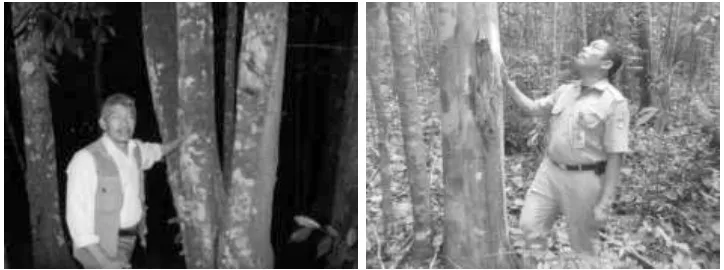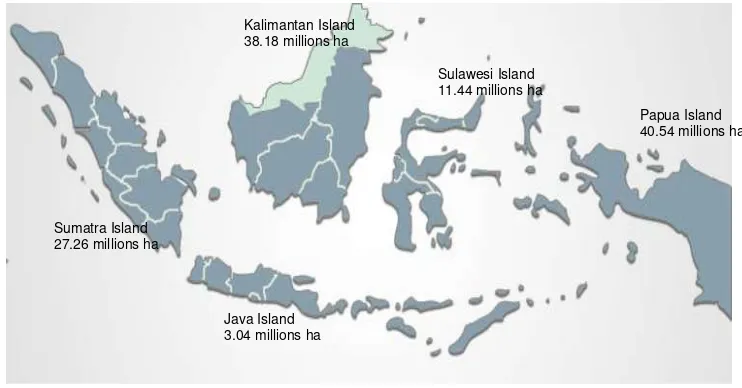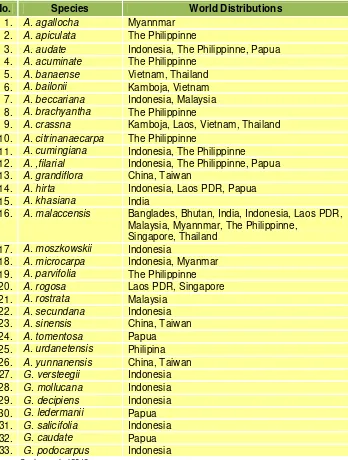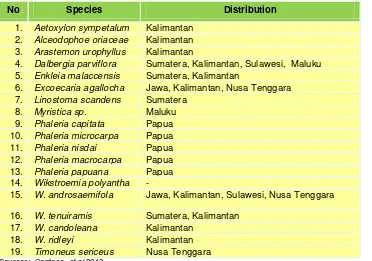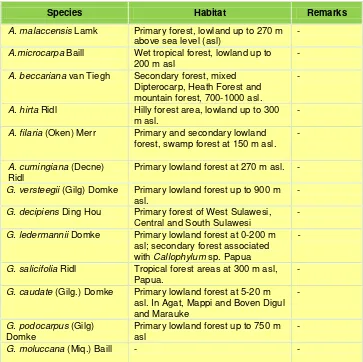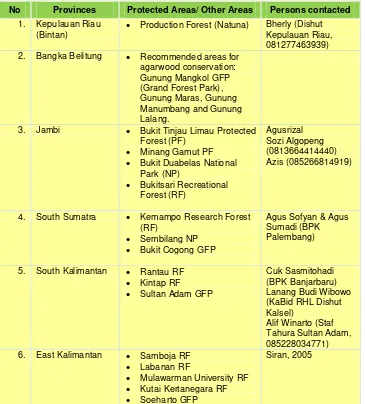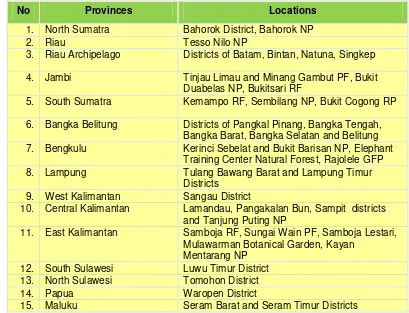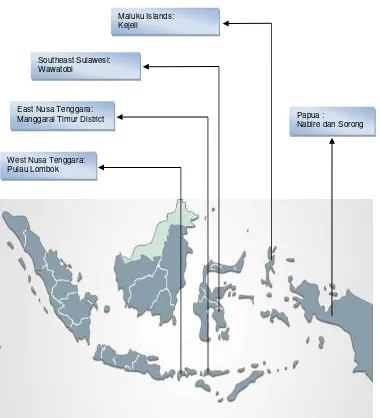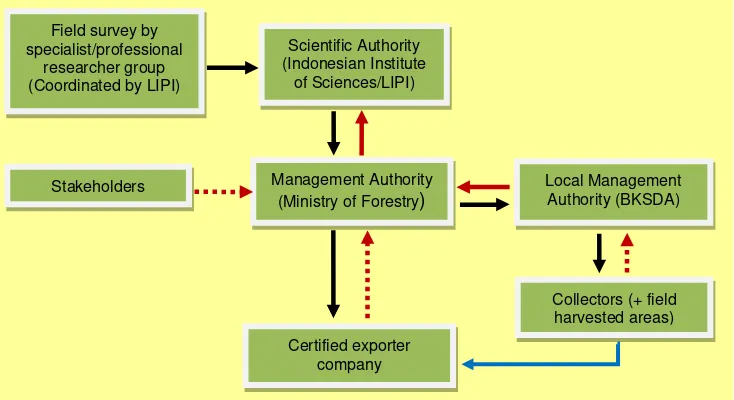IN
–
SITU
AND
EX
–
SITU CONSERVATION
OF AQUILARIA AND GYRINOPS:
A REVIEW
Oleh:
Tajudin Edy Komar Marfuah Wardani Faustina Ida Hardjanti
Nurul Ramdhania
Ministry of Forestry
Forestry Research and Development
Center for Conservation and Rehabilitation Research and Development
in cooperation with
International Tropical Timber Organization
(ITTO)
–
CITES Phase II Project
IN-SITU AND EX-SITU CONSERVATION OF AQUILARIA AND GYRINOPS:
A REVIEW
Authors:
Tajudin Edy Komar Marfuah Wardani Faustina Ida Hardjanti Nurul Ramdhania
Editors: Bismark Erdy Santoso
Agustinus P. Tampubolon
Desain Cover:
Agustina Dwi Setyowati
Copyright © 2014 Center for Conservation and Rehabilitation Research and Development in cooperation with International Tropical Timber Organization (ITTO) – CITES Phase II Project
ISBN: 978-602-1681-24-4
Published by
Center for Conservation and Rehabilitation Research and Development International Tropical Timber Organization (ITTO) – CITES Phase II Project Jl. Gunung Batu No. 5 Bogor, Indonesia
Telp. +62-251-8633234, Fax. +62-251-8638111
Printed by: IPB Press
Bogor, Desember 2014
PREFACE
Agarwood is a high value non-timber forest product, produced from natural infestation and artificial inoculation with microorganism. Seven genera, Aquilaria, Gyrinops, Aetoxylon,
Gonystylus, Eukbia, Wikstroemia and Paleria have been known as source of agarwood. However, current primary producer of agarwood are from Aquilaria and Gyrinops. Since the value of this NTFP is relatively high, the collections of agarwood from the wild since last two decades have been severe and the method of collection is mostly unsustainable. Unsustainable collection and the presence of various disturbances of the habitat have made the population and habitat of the species and genera of Aquilaria and Gyrinops
rapidly decreased and in some extent may have gone to extinct. In order to conserve and rescue the species, population and habitats, several field actions are needed to be carried out. Reviews of on the status of the species, population and habitats have been conducted. Some necessary information may have not been incorporated in this review, however the status of conservation of the species, population and habitat in general have been captured in the review.
We thanks to all parties who have made valuable contribution to this report from data collection draft preparation and completion of this report.
Director of CCR
EXECUTIVE SUMMARY
In situ and ex situ conservation of Aquilaria and Gyrinops: A review.
Agarwoods is one of Non-Timber Forest Product produced as result from physiological response to the micro-organism infection to Aquilaria and Gyrinops species. This aromatic product from those species has been used, among others, for medicines, cosmetic, incences and other aromatic based materials, including parfumes and uses as for traditional, ceremonial, cultural events and modern-day lifestyle. There are four genera widely known as agarwood producing species: Aquilaria, Gyrinops, Aetoxylon and Gonystylus. However, current major producers of agarwood are from the species of
vi
LIST OF CONTENT
PREFACE ... iii
EXECUTIVE SUMMARY ... v
LIST OF CONTENT ... vii
LIST OF TABLE ... ix
LIST OF FIGURE ... xi
LIST OF APPENDICES ... xii
ABBREVIATION ... xv
ABOUT AUTHORS ... xvii
PART 1. INTRODUCTION ... 1
1.1 Background ... 3
1.2. Objective ... 4
1.3. Terminology ... 5
1.4. Methodology ... 6
PART 2. NATURAL DISTRIBUTION OF AQUILARIA AND GYRINOPS ... 9
2.1. Forest Resources and Floristic Diversity ... 11
2.2. Geographical Distribution ... 12
2.3. Ecological Distribution ... 12
PART 3 GAPS AND PROBLEMS ON AGARWOOD SUSTAINABLE HARVEST AND CONSERVATION ... 21
3.1 Deforestation and Habitat and Population Lost ... 23
3.2. Agarwood Harvest From the Wild ... 23
3.3. The Drivers of Agarwood Harvest ... 27
3.4. The Sustainability of Agarwood Harvest ... 27
3.5. Method of Harvesting ... 28
3.6. Traditional Local Knowledge and Local Wisdom ... 28
3.7. Data and Information on Potential Production and Distribution ... 29
3.8. Technology for Processing ... 29
3.9 Production, Distribution and Export Control ... 29
3.10. Awareness on the Importance of Sustainable Harvest and Conservation ... 31
3.11. Quota Setting ... 31
3.12. Management Plan Toward Sustainable Harvest and Conservation ... 32
3.13. Expansion of Market Information ... 32
3.14. Reducing Viable Stands of Agarwood Trees ... 33
3.15. Genetic Diversity and Conservation ... 33
viii
PART 4. CONSERVATION STATUS OF AQUILARIA AND GYRINOPS ... 37
4.1. In-situ Conservation ... 39
4.1.1. Genetic resources inventories and survey ... 39
4.1.2. Activities on in-situ genetic conservation ... 40
4.1.3. Major needs for in-situ conservation of Aquilaria and Gyrinops ... 40
4.2. Ex-situ Conservation ... 40
4.2.1. Collection initiatives ... 41
4.2.2. Germplasm movement ... 42
4.2.3. Major needs for ex-situ conservation ... 43
4.3. Challenges for Conservation of Plant Genetic Resources of Aquilaria and Gyrinops ... 44
4.3.1. Quota setting... 44
4.3.2. Hybridization and inbreeding ... 44
4.3.3. Decreasing natural regeneration ... 44
4.3.4. Massive indiscrimate felling ... 45
4.3.5. Genetic erosion ... 45
4.3.6. Ensuring sustainable harvest ... 45
4.3.7. Agarwood quality and their standardization ... 46
4.3.8. Research needs ... 46
PART 5. STRATEGIC ACTION AND RECOMMENDATION FOR CONSERVATION OF AQUILARIA AND GYRINOPS ... 47
REFERENCE ... 53
LIST OF TABLE
Table 1. World distribution agarwood producing species, especially in
Asian countries, which are listed in Appendix II CITES ... 13
Table 2. Indonesian distribution of Aquilaria and Gyrinops (Roemantyo and Partomihardjo, 2010) ... 14
Table 3. Distribution of Non-CITES listed agarwood species in Indonesia ... 14
Table 4. Habitat distribution of some Aquilaria and Gyrinops species ... 15
Table 5. Aquilaria species recorded at field visit and direct discussion (interview) with related officers ... 16
Table 6. Distribution of Aquilaria species in Indonesia ... 17
Table 7. Distribution of Gyrinops species in Indonesia... 19
Table 8. Extinction category and the estimated period for occurance of extinction ... 34
LIST OF FIGURE
Figure 1. Aquilaria tree in Grand Forest Park Bukitsari, Jambi (Left) and
Protected Forst in Bintan Island (Right) (Photo by Tajudin Edy Komar) ... 7
Figure 2. Distribution of forest areas in some major island in Indonesia (Note:
Forest in relatively small island are not presented in the figure) ... 12
Figure 3. Geographical distribution of Aquilaria species ... 18 Figure 4. Geographical distribution of Gyrinops species ... 19 Figure 5. Procedure for determining quota of agarwood based
LIST OF APPENDICES
Appendix 1. Appendix 1. Quota and Associated Export until 2013 ... 59
Appendix 2. List of registered traders of agarwood
in DG. of FPNC (CITES MA) ... 60
ABBREVIATION
ASGARIN Asosiasi Pedagang Gaharu Indonesia (Association of Indonesia Agarwood Traders)
BKSDA Balai Konservasi Sumberdaya Alam ( Regional Office DG. of Forest Protection and Nature Conservation
BPS Badan Pusat Statistik (Central Statistic Bureau)
CITES Convention on International Trade of Endangered Species of Wild Fauna and Flora
DISHUT Dinas Kehutanan (Forest Services)
DG Directorate General
FORDA Forestry Research and Development Agency
FPNC Forest Protection and Nature Conservation
GFP Grand Forest Park (Taman Hutan Raya-Tahura)
IIS Indonesian Institute of Science (CITES Scientific Authority)
ITTO International Tropical Timber Organization
NDF Non-Detriment Finding
NP National Park (Taman Nasional)
NTFP Non-Timber Forest Product
PF Protected Forest (Hutan Lindung)
ABOUT AUTHORS
Tajudin Edy Komar. Senior researcher of the Center for Conservation and Rehabilitation R&D, Forestry Research and Development Agency (FORDA), Ministry of Forestry - Bogor.
Marfuah Wardhani. Senior Botanist of the Center for Conservation and Rehabilitation R&D, Forestry Research and Development Agency (FORDA), Ministry of Forestry - Bogor.
Faustina Ida. Senior officer of the CITES Management Authority, Directorate of Biodiversity Conservation, Directorate General of Forest Protection and Nature Conservation (PHKA) - Jakarta.
Nurul Ramdhania. Assistant in the collection and reparation of this report, Center for Conservation and Rehabilitation R&D, Bogor.
1.1. Background
Agarwood is one of non-timber forest products (NTFP) which has been collected from the wild since several decades ago. Recently, the agarwood has become one of the high economic value NTFPs with fantastic price, especially for premium quality. Before the year 2000, approximately 200 tonnes per year of agarwood was traded in Singapore and 70% of which originated from Indonesia. In the past, agarwood was primarily traded in some cities such as Pekanbaru (Sumatra), Surabaya (Java), Pontianak and Banjarmasin (Kalimantan) and other locations. Importing countries (consumers) of Indonesian agarwood are Singapore, Saudi Arabia, Taiwan, Japan, United Arab Emirates and Malaysia (Soehartono, 1999).
Agarwood is produced from seven genera: Aquilaria, Gyrinops, Aetoxylon, Gonystylus,
Eukbia, Wikstroemia and Paleria (Gratzfeld and Tan, 2008). However, major tree species producing agarwood in Indonesia are Aquilaria and Gyrinops (Roemantyo and Partomihardjo, 2010; Santoso et al, 2013). In general forestry term, agarwood is considered as one of NTFP. This product has received wide attention from various parties especially in international trade community due to its high economic value and conservation concern. Agarwood is produced as physiological response to the infection of plants part by microorganisme, such as fusarium. Agarwood differs from sandalwood for which sandalwood is having aromatic chemical substance inherent with the species. A number of synonims have been given by various authors for agarwood, such as alim, gaharu, karas, mengkaras, songgah (Indonesia), chingkaras, gaharu, galoop, kekaras and kepang (Malaysia) (Yusliansyah, 1997), agarwood, eaglewood, aloewood etc. Agarwood or eaglewood are commonly used term. No botanical name for agarwood as it is a product. Agarwood is mostly used for raw material for cosmetics, medicine, parfume and other modern-day lifestyle.
Until today, the harvest of agarwood in Indonesia is primarily from the wild and the method used might not be sustainable and therefore may have threatened the population and habitats, including their genetic resources. The export quota, which is annually determined by CITES Authorities (Management and Scientific) bears question with regard to its accuracy. This is because the existing data and information are still insufficient and mostly out of date, especially with respect to population density, regeneration and potential production of agarwood. Most of Aquilaria and Gyrinops species have been listed in Appendix of CITES, for which its international trade is regulated in accordance with rules and regulation, including setting annual quota to avoid over exploitation and destruction of the habitats and the remaining population (Soehartono and Newton, 2001).
In–Situ and Ex–Situ Conservation of Aquilaria and Gyrinops: A Review
4
agarwood collection and other necessary requirement to achieve the objective of the listings.
Recently, cultured plantation of selected Aquilaria species has been widely introduced in many areas, primarily in major islands (Sumatra, Java, Kalimantan. Sulawesi, Maluku and Papua). Some species which have been widely planted in cultured plantation are A. malaccensis, A. microcarpa and A. hirta and some Gyrinops species. Production of agarwood from cultured plantation (cultured agarwood) has gradually increased since last 3-4 years as shown in the data until 2013(see Appendix 1: Quota and associated export until 2013, from CITES MA, 2014). However, current production is still insignificant to reduce pressure on agarwood collection from natural population. Therefore, Directorate General of Forest Protection and Nature Conservation along with the Indonesian Science Institue as CITES Authorities of Indonesia encourage community to trade of agarwood from cultured plantation. At present, the CITES authorities continue registering the agarwood from cultured plantation.
The high economic value of agarwood has made the agarwood from the wild be a target for illegal harvest by collectors and the harvest method is mostly far from sustainable (Soehartono, Newton and Mardiastuti, 2002). Along with other forest disturbances (encroachment, illegal harvest, forest fires and conversion to other use), population of agarwood producing species has rapidly declined and this drastic decrease has also threatened the existence of the species in nature. Until recently, the status of conservation of those species have not been updated, eventhough some of the species have been listed in CITES Appendix. The availability of information regarding the populations, distribution and conservation is crucial for future action. Using this information, the appropriate treatment for each species could be developed. In addition, by obtaining sufficient data and accurate information on each species, the more accurate estimate of harvestable quantity of agarwood could be determined. By then, the ultimate objective of the inclusion into CITES Appendix could be achieved (Newton and Soehartono, 2001). CITES Authorities (scientific and managment), research institutions, universities, association (traders) and local communities play important role in achieving the CITES objective, especially for ensuring sustainable harvest and conservation of the species.
1.2. Objective
The objective of the activity is to explore and obtain information on the current status of
1.3. Terminology
Agarwood: a resinuous product formed by physiological response to alien micro-organism which infects certain part of the agarwood tree. Main stem and root are common parts in the tree infected by the microorganism.
Agarwood species: plant species naturally or artifically produced agarwood.
Agarwood tree: tree (large size woody plant) that produce agarwood.
Conservation: as an effort or action to protect living organism from various threat to extinction or lost.
Conservation area: areas of state forest which has unique characteristics and specifically designated and regulated by law primarily for protection of ecosystem, preserving various organisms and sustainable utilization. The conservation area consists of National Parks, Wildlife Reserve, Nature Reserves, Grand Forest Park and Nature Recreational Park.
Convertible forest area: state forest area due to low productivity and suitable for other uses could be converted to other non-forest uses.
Cultured agarwood: agarwood produced from cultured plantation by any agarwood growers.
Cultured Plantation: agarwood species planted for the production of agarwood with various ecological and biological treatments.
Forest Service: regional or local government offices responsible for managing forest and its associated resources in each level of government, such as Province (Provincial Forest Service) and District (District Forest Services).
Production Forests: state forests which function and be designated for timber and timber-based production and mostly managed by concession companies.
Protected Forest: a stateforest designated and regulated under current law for protection of forest and its role in hydro-orological function.
Grand Forest Park: a forest area managed for specific purpose primarily for ecosystem conservation and eco-tourism.
Quota: a set quantity of volume allowed to be exported.
In–Situ and Ex–Situ Conservation of Aquilaria and Gyrinops: A Review
6
Sustainable harvest: a harvest without causing damage or harmful to the population and habitat.
1.4. Methodology
Desk Study/Literature Search: data and information regarding the population, conservation and other related information was searched through the existing documents (printed and non printed), internet search and other sources.
Field Survey in selected sites: data and information compiled from the above sources were further observed to find what places to be field visit. This is because only limited places are posible to be field visited, due to time and funding constraints. In most cases, field visit is impossible since based on earlier information that agarwood producing species, primarily Aquilaria and Gyrinop are widely spread and scattered in by nature and by human related disturbances and activities.
Interview/Discussion: to enrich the previously collected data and information, interview and discussion with individual from government institutions (staff or higher authority in the institutions) and other competent persons, were carried out. The discussion also conducted to verify certain issues related to conservation. Provincial and District Forest Services, National Park Office and Regional Office of DG Forest Protection and Nature Conservation (DG PHKA), called BKSDA. Prior to field data collection and interviews, a technical workshop inviting competent personnels and relevant parties on agarwood was carried out. Draft reports were also presented to obtain comments and inputs to ensure the sufficiency of the content. To guide in the collection of data and information, a summary table is prepared as attached in Appendix 1. This table has been attempted to guide and ease in the collection of data and information on agarwood conservation.
PART 2.
NATURAL
DISTRIBUTION
OF
2.1. Forest Resources and Floristic Diversity
Total forest area in Indonesia is approximately 134,3 millions ha (Direktorat Pengukuhan dan Penatagunaan Kawasan Hutan, 2012, www.dephut.go.id/ uploads/files/bukupemanfaatanfinal.2012.pdf) distributed widely spread accross archipelago from western most of Sumatra until eastern most of Papua (Figure 2). Major islands are Sumatra, Java, Kalimantan, Sulawesi, Maluku, Nusa Tenggara and Papua. These forest areas are managed based on their main function, such as production forests (for timber production and timber base production, 76.6 millions ha), conservation areas (27 millions ha) and protected forests (for conservation and protection of ecological diversity and hydrology, 30.5 millions ha) and convertible forest. The latter is the forest areas which could be converted into other land uses for other development such as settlement, industries, fisheries and mining.
The forest resources are rich with biological diversity as the second rich biodiversity country after Brazil. The existing biodiversity consists of major floristic and animal diversity, such as trees, shrubs, lianas and other plant species. The species richness consists of at least 515 mammal species, 1,519 bird species, 270 amphibian species, 600 species of reptiles, 121 butterfly species and 20,000 flowering plant species (Mardiastuti
et al 2007).
Late 1970’s was the beginning of utilization of forest resources to generate natural economy. The natural resources exploited are timber, non timber forest products, mining and others which have economic value. However, the utilizations have also caused some damages to the environment. The exploitation of mining, logging and forest conversion to other uses have resulted to various negative impacts, especially on forest cover change and biological diversity. The forest cover changes influence floristic diversity and genetic variability.
The change of forest area during that period (from 1980 through 2000) might have given large contribution to the decrease and lost of biological diversity including agarwood natural population. Rapid decrease or lost of biological diversity and population could also lead to the lost of genetic diversity and genetic erosion after long period of time.
Substantial change of forest cover is comparatively shown between the period of 1980s and after 2000. The total area of state forest recorded in 2012 remains similar (134 millions ha), but physically, the non-covered forest area (deforested and degraded areas) has significantly increased and have removedseveral populations of Aquilaria and
In–Situ and Ex–Situ Conservation of Aquilaria and Gyrinops: A Review
12
and conversion of various types of forests has caused rapid decrease in Aquilaria and
Gyrinops population, diversity and distribution areas.
Source :Ditkuh, 2011 (http://ppkh.dephut.go.id/index.php/pages/postpublikasi/post/19)
Figure 2. Distribution of forest areas in some major island in Indonesia (Note: Forests in relatively small islands are not presented in the figure)
2.2. Geographical Distribution
World distribution of agarwood species has been summarized by Santoso et al 2013. As shown in Table 1. Agarwood is produced in most Asian countries for both CITES and non-CITES listed species. Four genera are naturally found in Indonesia: Aquilaria, Gyrinops,
Aetoxylon and Gonystylus. Species from those genera are distributed in Sumatra, Kalimantan, Sulawesi and Papua and other small islands. Based on herbarium specimen, two major genera Aquilaria and Gyrinops are the most frequently found, primarily in large islands. Aetoxylon and Gonystylus may have not been specifically inventoried as for agarwood species in that period. For the two genera, species from Aquilaria are found mostly in western parts of Indonesia, whereas species of Gyrinops are mostly found in eastern region, such as Molluccas, Nusa Tenggara and Papua (Yusliansyah, 1997;Roemantyo and Partomiharjo, 2010).
The change of forest cover to various uses (settlement, mining, estate crop plantation, industrial plantation, etc) has occurred in most of those forest areas. Even though, very limited information available on the impact of conversion to the existence of the species, it could be certain that population density of agarwood species has been decrease. Rapid decrease in population has caused various consequencies on agarwood natural regeneration.
Sumatra Island 27.26 millions ha
Java Island 3.04 millions ha
Kalimantan Island 38.18 millions ha
Sulawesi Island 11.44 millions ha
Table 1. World distribution agarwood producing species (Aquilaria and Gyrinops), especially in Asian countries, which are listed in Appendix II CITES
No. Species World Distributions
1. A. agallocha Myannmar 2. A. apiculata The Philippinne
3. A. audate Indonesia, The Philippinne, Papua 4. A. acuminate The Philippinne
5. A. banaense Vietnam, Thailand 6. A. bailonii Kamboja, Vietnam 7. A. beccariana Indonesia, Malaysia 8. A. brachyantha The Philippinne
9. A. crassna Kamboja, Laos, Vietnam, Thailand 10. A. citrinanaecarpa The Philippinne
11. A. cumingiana Indonesia, The Philippinne
12. A. ,filarial Indonesia, The Philippinne, Papua 13. A. grandiflora China, Taiwan
14. A. hirta Indonesia, Laos PDR, Papua 15. A. khasiana India
16. A. malaccensis Banglades, Bhutan, India, Indonesia, Laos PDR, Malaysia, Myannmar, The Philippinne,
Singapore, Thailand 17. A. moszkowskii Indonesia
18. A. microcarpa Indonesia, Myanmar 19. A. parvifolia The Philippinne 20. A. rogosa Laos PDR, Singapore 21. A. rostrata Malaysia
22. A. secundana Indonesia 23. A. sinensis China, Taiwan 24. A. tomentosa Papua
25. A. urdanetensis Philipina 26. A. yunnanensis China, Taiwan 27. G. versteegii Indonesia 28. G. mollucana Indonesia 29. G. decipiens Indonesia 30. G. ledermanii Papua 31. G. salicifolia Indonesia 32. G. caudate Papua 33. G. podocarpus Indonesia
In–Situ and Ex–Situ Conservation of Aquilaria and Gyrinops: A Review
14
Table 2. Indonesian distribution of Aquilaria and Gyrinops
No. Species Area of distributions
1. Aquilaria Sumatra, Kalimantan, Sulawesi, Maluku, Nusa Tenggara and Papua
2. A. malaccensis Sumatra, Kalimantan and other islands 3. A. microcarpa Sumatra, Kalimantan and other islands
4. A. brachyanta South Sumatra, Batam, Lingga, Bakung and Durian (Sumatra) 5. A. cumingiana Kalimantan, Sulawesi, Nusa Tenggara, Maluku and Papua 6. A. hirta South Sumatra, Batam, Lingga, Bakung and Durian (Sumatra),
Talaud, Kepulauan Maluku and Papua 7. Gyrinops Sulawesi, Nusa Tenggara, Maluku and Papua 8. G. ledermannii Papua Nugini
9. G. vertaegii Sulawesi (Minahasa) and Nusa Tenggara (Flores) 10. G. decifiens Southeast Sulawesi (Wawatobi)
11. G. molluccana Maluku
12. G. solicifolia Nabire and Sorong, Papua 13. G. podocarpus Nabire and Sorong, Papua
Sources: Roemantyo and Partomihardjo, 2010.
Table 3. Distribution of Non-CITES listed agarwood producing species in Indonesia
No Species Distribution
1. Aetoxylon sympetalum Kalimantan 2. Alceodophoe oriaceae Kalimantan 3. Arastemon urophyllus Kalimantan
4. Dalbergia parviflora Sumatera, Kalimantan, Sulawesi, Maluku 5. Enkleia malaccensis Sumatera, Kalimantan
6. Excoecaria agallocha Jawa, Kalimantan, Nusa Tenggara 7. Linostoma scandens Sumatera
8. Myristica sp. Maluku 9. Phaleria capitata Papua 10. Phaleria microcarpa Papua 11. Phaleria nisdai Papua 12. Phaleria macrocarpa Papua 13. Phaleria papuana Papua 14. Wikstroemia polyantha -
15. W. androsaemifola Jawa, Kalimantan, Sulawesi, Nusa Tenggara 16. W. tenuiramis Sumatera, Kalimantan
17. W. candoleana Kalimantan 18. W. ridleyi Kalimantan 19. Timoneus sericeus Nusa Tenggara
Table 4. Habitat distribution of some Aquilaria and Gyrinops species
Species Habitat Remarks
A. malaccensis Lamk Primary forest, lowland up to 270 m above sea level (asl)
-
A.microcarpa Baill Wet tropical forest, lowland up to 200 m asl
-
A. beccariana van Tiegh Secondary forest, mixed Dipterocarp, Heath Forest and mountain forest, 700-1000 asl.
-
A. hirta Ridl Hilly forest area, lowland up to 300 m asl.
-
A. filaria (Oken) Merr Primary and secondary lowland forest, swamp forest at 150 m asl.
-
A. cumingiana (Decne) Ridl
Primary lowland forest at 270 m asl. -
G. versteegii (Gilg) Domke Primary lowland forest up to 900 m asl.
-
G. decipiens Ding Hou Primary forest of West Sulawesi, Central and South Sulawesi
-
G. ledermannii Domke Primary lowland forest at 0-200 m asl; secondary forest associated with Callophylum sp. Papua
-
G. salicifolia Ridl Tropical forest areas at 300 m asl, Papua.
-
G. caudate (Gilg.) Domke Primary lowland forest at 5-20 m asl. In Agat, Mappi and Boven Digul and Marauke
-
G. podocarpus (Gilg) Domke
Primary lowland forest up to 750 m asl
-
G. moluccana (Miq.) Baill - -
Source: Kalima, Susilo and Santoso, 2014
2.3. Ecological Distribution
Species of Aquilaria and Gyrinops grow in a wide range of habitats, soil types and elevation. Natural habitats in general are primary, logged over area, secondary forest, community plantation (rubber and other tree plantation) and even in recovered ex-burn forest area and heath forest. Most of Aquilaria and Gyrinops, grow in various types of soils, except for some species with soil preference and species association. Elevation ranges from lowland areas to hilly mountain up to 700 m above sea level (Table 4). Most species of these two genera occupy higher canopy level in the forest canopy system of
In–Situ and Ex–Situ Conservation of Aquilaria and Gyrinops: A Review
16
40 cm (CITES Authorities: Report on NDF of Agarwood for Sustainable Harvest in Indonesia).
Currently, information on the growth of agarwood natural population is still limited. ASGARIN (2004, cited in the Report on NDF of agarwood for sustainable harvest in Indonesia), mentioned the annual growth of A. malaccensis reaches 0.5 cm/year and for its cultured plantation could achieve 2 cm/year.
Table 5. Aquilaria species recorded at field visit and direct discussion (interview) with related officers
No Provinces Protected Areas/ Other Areas Persons contacted 1. Kepulauan Riau
(Bintan)
Production Forest (Natuna) Bherly (Dishut Kepulauan Riau, Bukit Duabelas National
Park (NP)
Mulawarman University RF Kutai Kertanegara RF Soeharto GFP
Table 6. Distribution of Aquilaria species in Indonesia
No Provinces Locations
1. North Sumatra Bahorok District, Bahorok NP
2. Riau Tesso Nilo NP
3. Riau Archipelago Districts of Batam, Bintan, Natuna, Singkep
4. Jambi Tinjau Limau and Minang Gambut PF, Bukit Duabelas NP, Bukitsari RF
5. South Sumatra Kemampo RF, Sembilang NP, Bukit Cogong RP
6. Bangka Belitung Districts of Pangkal Pinang, Bangka Tengah, Bangka Barat, Bangka Selatan and Belitung 7. Bengkulu Kerinci Sebelat and Bukit Barisan NP, Elephant
Training Center Natural Forest, Rajolele GFP
8. Lampung Tulang Bawang Barat and Lampung Timur
Districts 9. West Kalimantan Sangau District
10. Central Kalimantan Lamandau, Pangakalan Bun, Sampit districts and Tanjung Puting NP
11. East Kalimantan Samboja RF, Sungai Wain PF, Samboja Lestari, Mulawarman Botanical Garden, Kayan
Mentarang NP 12. South Sulawesi Luwu Timur District 13. North Sulawesi Tomohon District
14. Papua Waropen District
Figure 3. Geographical distribution of Aquilaria species
South Sumatra: Kemampo RF Sembilang NP Bukit Congong RP Riau Archipelago: Batam, Bintan & Natuna
East Kalimantan: Wanariset RF Sungai Wain PF Samboja Lestari RF
Mulawarman Botanical Garden Kayan Mentarang NF
West Kalimantan: Sangau District
South Sulawesi: Luwu Timur District
Jambi:
Bukit Tinjau Limau PF Bukit Minang Gambut PF Bukit Duabelas NP Bukitsari RF
Riau: Tesso Nilo NP
Bengkulu: Kerinci Sebelat NP Bukit Barisan NP
Elephant Training Center NP Rajolele GFP
Lampung:
Tulang Bawang Barat District Lampung Timur District
Bangka Belitung: Pangkal Pinang District
1
Table 7. Distribution of Gyrinops species in Indonesia
No Provinces Locations
1. Southeast Sulawesi Wawatobi
2. Maluku Islands Kejeli
3. West Nusa Tenggara Pulau Lombok
4. East Nusa Tenggara Manggarai Timur District
5. Papua Nabire dan Sorong
Figure 4. Geographical distribution of Gyrinops species
East Nusa Tenggara: Manggarai Timur District
Southeast Sulawesi: Wawatobi
Maluku Islands: Kejeli
West Nusa Tenggara: Pulau Lombok
Papua :
3.1. Deforestation, Habitat Degradation and Population Lost
Tropical forests in Indonesia are widely spread to all over islands in the archipelago. Species of Aquilaria and Gyrinops have been reported to be found in almost all of those islands (Table 2.), whichever the function of the forests (production forest, conservation area, protected forests and convertible forest area). Even though, the population density of those species is relatively low (rare), the lost of habitat could cause the lost of entire population of the species. This condition has been confirmed by Roemantyo and Partomihardjo (2010), using herbarium specimen and landcover change. In the period of 1997-2000, the rate of deforestation and forest degradation has been predicted to be 2.83 millions ha per year and the rate decreased to 1.51 millions ha in the period of
2000-2009. The large deforestation areas occur primarily in Sumatra and Kalimantan (Forest Watch Indonesia, 2011). Even though the deforestation rate decreases afterword, the significant lost of agarwood trees (Aquilaria and Gyrinops) may have occurred. The lost population and habitat would not be naturally restored through natural regeneration, unless, intensive intervention be given, especially through artificial regeneration and or enrichment planting.
3.2. Agarwood Harvest From The Wild
In–Situ and Ex–Situ Conservation of Aquilaria and Gyrinops: A Review
24
system that in the first instance matched the current levels of trade, but which could later
be manipulated. Quotas were initially “harvest guides”, and in the first years exports
frequently exceeded quotas. This was due to stockpiles and the increasing value of specimens such as snakes skin in the late 1980s creating a higher demand, and resulting in more harvesting.
The current protocol for establishing annual quotas is now more precautionary. Each year, Management Authority (PHKA) officers in each Province establish harvest levels in the field, which are reviewed and assessed further by the CITES Scientific Authority (LIPI). The review and assessment is now also involving some related Non-Government Organization (NGOs). Various parameters, including environmental conditions, are now used to set quotas (e.g. quotas in 1998 decreased due to extensive forest fires in Indonesia the previous year). This also, then improved by the survey results for certain species. Population monitoring program is being developed to support the non-detriment findings as the basis for quota establishment. Once quotas are finalized, DG FPNC issues an annual decree on the national allowable harvest.
Trade controls and enforcement
All CITES Appendix-II listed species in Indonesia are controlled, in term of harvest quota, domestic transport and export, by the DG of FPNC as CITES Management Authority (The Decree of the Minister of Forestry Number 447/Kpts-II/2003) as follows:
a. Regulation of wild harvesting
To control trade of listed species in Appendix II CITES, the DG of FPNC sets annual catch quotas based on recommendation from Scientific Authority. This quota is set up based on provincial quotas. Each provincial quota is managed by the local office of DG FPNC (BKSDA) which also acts as provincial offices of CITES Management Authority.
The provincial offices of CITES Management Authority (BKSDA) also control and enforce harvest or collection permits, and implement quota management and monitoring, for CITES-listed species in all administrative jurisdictions. In accordance with the Decree of the Minister of Forestry No. 447 of 2003, BKSDA will issue permits to collect species including snake in the field based on the quota allocated for each respective province. Species that harvested from the wild (forest) are officially registered by Sub-provincial Section Offices of BKSDA and then forwarded to the provincial office of DG of FPNC (BKSDA).
or capture of wild plants and animals sourced from the captive management, can only be undertaken from the management units in accordance with the current legislation.
b. The permit granting
Only registered collectors and exporters are granted permits from DG of FPNC as CITES Management Authority. The permit is granted based on annual quota that set under the Ministrial Decree (No. 447/Kpts-II/2003). The DG of PFNC has also allocated the annual quota in every potential province for agarwood production. The Provincial Offices of the FPNC (BKSDA) then issues harvest permits and domestic transport permit or licence but not exceeding the allocated amount or quota. Based on those permits, the DG of FPNC (CITES Management Authority) issues CITES export permits. Currently, there are only around 30 registered collectors/ exporters of agarwood nation wide (See Appendix 2).
c. The monitoring actions
In accordance with the Ministrial Decree (No. 447 of 2003), the BKSDA or its Sections must undertake monitoring through regular inspection of the registered collectors (middlemen traders). Each office produces official records, and then forwarded to the provincial of DG of FPNC (BKSDA) and then to DG of FPNC for compilation. These records and reports are undertaken at any time of inspection. This inspection is undertaken to ensure that the harvest not exceeding the permitted amounts.All shipments are verified and checked by the provincial office of DG of FPNC (BKSDA) whose officers are posted in the designated international ports.
d. Trade chain custody
For domestic transport, the specimens must be covered by permits issued by BKSDA or its Section Offices. To facilitate better control, the domestic transport permit is, started from January 2005, now standardized throughout Indonesia. All permits (collection and domestic transport permits) are required to be reported to DG of FPNC (CITES MA) for easy monitoring of internal (domestic) trade. For international trade, several import/export points have been nominated for Indonesia’s CITES trade.
A chain of custody between source regions and collection points within Indonesia is theoretically possible to a certain degree of accuracy. Since each province has been divided into a number of BKSDA jurisdictions.
Standardized permits are now being issued by BKSDA, in accordance with a Decree by DG of FPNC, for which from 2005, five separate papers must accompany internal shipments within Indonesia. In addition, there is a monthly resolution by BKSDA offices to report levels of internal transport to the DG of FPNC (as the CITES MA). The five separate papers are as follows:
- The first copy must follow the specimen;
In–Situ and Ex–Situ Conservation of Aquilaria and Gyrinops: A Review
26
- The third copy is sent to the central office as the file for FPNC and used for crosschecking with the original which is enclosed with application for export;
- The fourth copy is file for BKSDA destination and used for cross checking with the original when the shipment has arrived; and
- The fifth copy is for the Section of BKSDA. accordance with the provision of the regulation and may be liable to imprisonment (in accordance with the Customs and Excise Law) and or fines of maximum IDR 250 millions (about USD 27,000).
To curtail smuggling of snake and other species, the Government of Indonesia has provided training (in annual basis) on CITES and wildlife law enforcement for field officers and officials of Special Forestry Police and Civil Investigator of BKSDA, Customs, Quarantine and State Police. Coordination and cooperation among CITES Management Authority and the Customs and Quarantine are in the process of formalization in the forms of MOU.
Forestry Minister Decree No. 447 of 2003 has established a ‘chain of custody’ on trade management as follows:
i. BKSDA issues collection permits based on the annual quota for each province and provides reports in regular basis to the central office of the CITES Management Authority (DG of FPNC) on the permits they have issued;
ii. BKSDA and or its Sections provide official records on the stock accumulated by collectors prior to transport from points of origin, as well as in warehouses at points of export (e.g. Jakarta, Surabaya, Pakanbaru);
iii. BKSDA and or Sections issue standardized domestic transport permits at points of origin. Copies of these permits are sent to BKSDA at the destination port, the central office of the CITES Management Authority and the respective trading company. Generally, the domestic transport permit identifies the scientific name of the specimen down to species level;
v. Based on the reports, official records and domestic transport permits the central office of the CITES Management Authority issues CITES export permits to registered exporters (members of association);
vi. Officials from Customs or Plant Quarantine or BKSDA authorities at the port of export undertake verification of the permits to assure that the specimen being exported is in accordance with the permit;
vii. Customs, Quarantine and BKSDA authorities at the port of export each holds one copy of the CITES export permits;
viii. For Customs and statistical purposes the exporter is required to declare the export on the Export Declaration form, in addition to the CITES export permit. This information is compiled by the Central Bureau of Statistics (BPS), and thus provides another method of cross-checking trade statistics.
3.3. The Drivers of Agarwood Harvest
Agarwood is one of the high value priced non timber forest products. The price of premium quality of natural agarwood ranges from US $ 200 to US $ 5,000 per killogram. The price may be higher in accordance with the quality, market performance and trade-market chain. For agarwood oil, the oil price can be sold for around US$10,000-14,000 per kg (Gratzfel and Tan, 2008). The agarwood collectors are primarily the farmersfrom local community (resident collectors) and non-resident collectors who are deployed to collect agarwood in certain area (Soehartono, 1999). These collectors are approached by local traders or middleman in the trade chain to search and collect the agarwood from natural populations. Mostly, they are lack of understanding, in some extent, neglect the existing laws and regulations imposed on the harvest of non timber forest products in state forest including wild flora and fauna. This occurs in most places, not only for agarwood collection, but also for other non timber forest products, from Western most of Sumatra to Papua where the natural resources are located. As other products, the high price of natural agarwood could easily attract all levels of community, whatever the social status in community, to be part of the agarwood collection and or trade.
3.4. The Sustainability of Agarwood Harvest
The harvest of agarwood from the wild may have not been sustainable. Newton and Soehatono 2001 has assessed the sustainability of agarwood harvest using three different observation aspects on Aquilaria species in Sumatra and Kalimantan. The aspects were the information (data) on the population status, natural distribution and the impact of harvesting on regeneration. The data predicted were the number of existing
In–Situ and Ex–Situ Conservation of Aquilaria and Gyrinops: A Review
28
The number of existing population (individuals). Newton and Soehartono (2001) conducted an analyses on the data collected from National Forest Inventory (NFI). They found the population density of these three species is relatively low, range from 0.36-1.17 individuals per ha for both Sumatra and Kalimantan.
The number of tree harvested. For the number of tree harvested for agarwood collection, they made analyses from data derived from the estimate of mass agarwood traded from official figure (data officially released by CITES Authorities) multiplied by conversion factor. The conversion factor is derived from the amount of agarwood harvested per treedetermined based on field observation. Their analyses indicated that between 1991-1996, the number of agarwood trees felled was approximately 61.000 trees per year. This estimate could indicate how serious the impact of trade on tree felling during that period.
Regeneration Capacity. Three species of Aquilaria observed by Newton and Soehartono (2001) indicated that those species are highly fecund (relatively high regeneration capacity). Each individual tree could produce up to 19000 seeds and nearly 92% germination after one month. Eventhough, the seedling survival was only 20% after 15 months and with the presence of various disturbances, the results indicated that in the absence of harvesting, those species populations are selft-sustaining.
The impact of harvesting on sustainability. Newton and Soehartono (2001) analyzed the impact of harvesting of some Aquilaria species in the wild using different harvesting scenario. The results indicated that (1). A single harvest of all trees for A malaccensis
with diameter above 5cm would cause population decline to extinction, (2) Similarly, the harvest of A. microcarpa with diameter above 10 cm dbh would also result similar pattern. It means that if agarwood collectors harvest most of the trees (>90% of the existing trees in that diameter), the population would decline and the harvest is not sustainable (Soehartono and Newton, 2002).
3.5. Method of Harvesting
Agarwood resin might spread throughout the stem, branchs or root. The natural formation of agarwood does not follow particular pattern, but random based on the infection by microorganism. The product is invisible from outside and until now the reliable method to detect location of agarwood in the tree is not yet available. Soehartono (1999) has summarized the currrent method of agarwood collection, one is through direct felling of the agarwood trees and the other one is by slicing (barking) the trunk to detect the presence of agarwood. The first method is highly destructive and making rapid decline in population.
3.6. Traditional Knowledge and Local Wisdom
(collectors living nearby the target location). For non-resident collectors (collectors employed temporarily by middleman or local traders) mostly use their daily experience and knowledge obtained after long period of being agarwood collector (Soehartono 1999). Regardless the existing law which prohibit the commercial collection of any materials from conservation areas and protected forest, the method or technique to detect agarwood in living and standing tree is still valuable to be developed for future uses.
3.7. Data and Information on Potential Production and Distribution
Species of Aquilaria and Gyrinops are widely distributed in Indonesia as described elsewhere in this review, however, more accurate and up dated data and information on current distribution & potential agarwood production remain unavailable. Herbarium specimens collected early 1970’s (Roemantyo and Partomiharjo, 2010) and National Forest Inventory (NFI) (Soehartono and Newton, 2001) have confirmed wide distribution of
Aquilaria throughout in Indonesia. The information on species distribution, potential agarwood production (number of agarwood trees), regeneration capacity and the number of tree being harvested (agarwood quantitiy) are needed to determine whether the harvest is sustainable (Soehartono and Newton, 2001) and to determine more accurate annual quota for production and export. These data also used for setting up management and conservation strategy.
3.8. Technology for Processing
There are several forms of agarwood products freshly collected from the wild. They are logs, chips, blocks, branches, twigs, and roots. Other finish or half-finish products, other than pure agarwood oil or mixed oil, are carving, handicrafts, beads, prayer beads, neclaces and bracelet. Fresly collected agarwood product from the wild need further classification in order to determine the price. Currently, the processing of agarwood product still requires relatively high technology and expensive. This makes the trade is mostly in unprocessed form and therefore they are priced lower than expected. In order to improve the value (quality) and the price, processing technology need to be developed which user friendly and affordable by ordinary community and local traders. National Standardization Board has introduced standard quality for agarwood product. Agarwood quality is determined based on color, incence content and aromatic strength. Other specific chemical substance will be further used to categorize agarwood quality.
3.9. Production, Distribution and Export Control
There are several control measures to ensure the sustainable harvest and conservation of agarwood. The control are conducted at stages of production, distribution and export.
eco-In–Situ and Ex–Situ Conservation of Aquilaria and Gyrinops: A Review
30
education, research, development and traditional utilization. It means, it is not allowed to harvest any products (timber and non-timber forest products), except for those purposes. The collection or harvest of timber and non-timber forest products including all environmental services in concession forest or other forests (including community forest) are regulated under each forest management unit, which is embedded to the companies permit.
At distribution/transhipment. Agarwood is classified as wild plants and animals for which their distribution is regulated by CITES Management Authority (DG of FPNC). CITES MA issued a regulation on the distribution or transhipment of those products, for which the distribution and transhipment of those product must be accompanied by a document permit issued by Regional office of CITES MA (BKSDA) as described earlier. One of the documents is Surat Angkut Tumbuhan Dalam Negeri (SAT – DN) for domestic transhipment and Surat Angkut Tumbuhan Luar Negeri (SAT – LN) for overseas transhipment. This document is granted after being inspected and verified by regional office of CITES MA (BKSDA) which is located at provincial level. In the field, this type of control has not been fully effective and hard to be monitored and therefore smuggling is taking place. Eventhough, capacity building has been annually conducted to improve skills and knowledge of various stakeholders.
To ease domestic control, BKSDA issued permit based on provincial quota to the registered traders (exporters) as described in the previous section and zoning. Agarwood from western parts (west zone) of Indonesia called as Malaccensis groups (A. malaccensis, A. microcarpa, A. beccariana and A. hirta) and those sourced from eastern parts of Indonesia called Filaria groups (A. filaria, A. cumingiana, G. versteegii, G. moluccana, G. podocarpus, G. decifiens, G. salicifolia, G. caudate and G. ladermanii). Filaria groups are from Western Papua, Moluccas and Lesser Sunda. These two groups are not overlapping in their distribution (CITES Authorities: Report on NDF of Agarwood for sustainable harvest in Indonesia, not dated).
Export regulation. International trade control of agarwood product is through trade convention (CITES). All species of Aquilaria and Gyrinops have been listed under Appendix II of CITES. The export of products listed under CITES Appendix (pure agarwood, mixed oil, logs, chips, block, branches and twigs, roots, seedling, sawdust and powder, carving and hadycraft, beads, prayer beads, neclaces and bacelets) is required to be accompanied by export permit from CITES MA (Asia Regional Workshop on Agarwood, Bangka, November 2011). The issuance of this permit has been described in the previous section only registered traders (exporters) granted permit as shown in Appendix 2 (Appendix 2. List of registered exporters, obtained from Faustina Ida, CITES MA, 2014).
The weakness. As countered by Gerard A. Persoon (Agarwood: the life of wounded tree,
IIAS Newsletter #45, Autum 2007) that “agarwood is relatively hard to monitor and control.
differentiation between wild and cultivated agarwood”. Domestic control of agarwood product is also hardly carried out, since the detection measures and apparatus are not yet available.
3.10. Awareness on the Importance of Sustainable Harvest and
Conservation
In general, agarwood collectors and ordinary communities are unaware or in some extent neglect the importanceof sustainable harvest and conservation of genetic resources. In order to improve awareness, CITES Authorities have regularly organized capacity buildling (knowledge and understanding) on conservation and CITES issues. This capacity buildling may have been insufficient to cover all stakeholders and interested parties on agarwood. Primary stakeholders of agarwoods are Regional Office for DG of FPNC (BKSDA), Forestry Services, Local NGO, community leaders, registered and non-registered collectors and traders, including association and other agarwood communities. Other dissemination events have also been regularly carried out, especially at the quota determination and for control of species (germ plasm) movement from the original site. More specific campaigns and disseminations might be needed for wider audience.
3.11. Quota Setting
In–Situ and Ex–Situ Conservation of Aquilaria and Gyrinops: A Review
32
Figure 5. Procedure for determining quota of agarwood based on Non-Detriment Finding
(Source: CITES Authorities: Report on the sustainabe harvest and Indonesian)
3.12. Management
Plan
Toward
Sustainable
Harvest
and
Conservation
DG of FPNC, is an institution under Ministry of Forestry, has a mandate to ensure the achievement of conservation of biological diversity in Indonesia. The biological diversity consists of ecosystem, species and genetic variability of each species. In order to achieve the objective, DG of FPNC, has formulated a general strategy for sustainability and conservation of Indonesian biological diversity in 2007 by Mardiastuti et al 2007. This strategy has been formally disseminated. However, for their field action, it needs further eloboration for the specific species including agarwood. For example, species of Aquilaria
and Gyrinops, under national law are not as protected species. They are only regulated under CITES for their International trade, the distribution and transhipment (under SAT-DN and SAT-LN (DG of FPNC)) as described earlier.
3.13. Expansion of Market Information
However, despite the large potential production from culture plantation, trade and market of agarwood product are still limited in term of access and information for common agarwood growers. The market of this product has been limited to certain traders and exporters. Agarwood growers are frequently do not receive clear information on how and where the agarwood product to be traded. Currently, the collection and trade is primarily through the the local traders and exporters registered under CITES MA or through natural agarwood association (Indonesian Association of Agarwood Exporters - Asgarin). Recently, some agarwood growers in each region have formed their own group as farmers group. These farmers groups will play an important role in the production and trade of agarwood from cultured plantation. The role of government and association is needed to provide market information and trade expansion.
3.14. Reducing Viable Stands of Agarwood Trees
Large collection of agarwood form the wild which occurs since several decades has caused massive felling of agarwood trees, especially Aquilaria and Gyrinops as described in earlier section. The tree felling by agarwood collectors is mostly is destructive to the existing stands, and frequently cause dead of trees in various growing stages, beside the drastic decline or lost of seed or mother trees and stand composition (Soehartono, Newton and Mardiastuti, 2001). The change of species composition and reduction of seed trees could cause reduction in reproductive capacity and regeneration of the species (Soehartono and Newton, 2001). Even though some species like A. malaccensis and
A. microcarpa have relatively higherregeneration capacity at undisturbed-natural condition. Reducing density of mother trees could also cause mating in closely related individual and high potential for inbreeding, which in turn reducing viable stand of the species. Inbreeding or mating with closely related individual could cause detrimental effect to the subsequent population (Widiyatmoko, 2012).
3.15. Genetic Diversity and Conservation
Natural agarwood population has declined in recent years due to various reasons as desrcibed earlier. Decrease in population density (a number of individual per area) will lead to the increased distance between individuals, which potentially reduces outcrossing rate(high probability of inbreeding). This has occured in some Dipterocarp species caused by severe logging activity. Inbred population mostly experiences depression, which in turn, deteriorate the subsequent population and reducing genetic variation (Indrioko, 2012).
In–Situ and Ex–Situ Conservation of Aquilaria and Gyrinops: A Review
34
differentiated using morphological characters, except fruits and seeds (Mathius, Rahmawati and Anidah, 2009).
In undisturbed population (natural density) of Aquilaria and Gyrinops shows relatively high genetic variability between populations and within population (Widiyatmoko, 2012). The genetic variation will eventually decrease along with the decrease in population size and lost of seed (mother) trees source which means the exclusion of certain gene resources (allele). Low genetic diversity and extreme limited population size will cause serious threat to extinction due to adverse environmental condition and the attack of pests and diseases. Planting in monocultured design and outside original habitat is mostly vulnerable, especially to pest and diseases (Susmianto and Santoso, 2013). Some incidences of pest occur in Sumatra.
Table 8. Extinction category and the estimated period for occurance of extinction
No. Category Probability of extinction Duration estimated
1. Vulnerable 10% 100 years
Source: IUCN, 1996 (cited from Indrioko, 2012).
Theoritically, the conservation of plant genetic resources should be directed to maintain the random change of allele (unique alleles), outcrossing rate, population management which enable natural pollination (Indrioko, 2012). Therefore, in order to conserve agarwood plant genetic resources, several aspects need to considered, such as sufficient representation of genetic diversity, early detection on genetic relationship between individuals, clear interpretation of taxonomical status of each species and collection of seeds only at peak flowering seasons.
3.16. Untraceable Origin of Cultured Plantation
Agarwood species has been extensively planted by various agarwood communities accross the country, such as A. malaccensis, A. microcarpa, A. hirta and some
Gyrinops. The high value-price, the readiness for culture plantation, wide availability of planting materials and relatively short period for production have made this NTFP popular and promising to be main source of income in Forestry. Campaign and local government support to culture-plantation of agarwood have also made significant contribution to the
‘booming’ in last decade. In addition, innoculation technology has also been available to promote agarwood production, regardless the inconsistency of result, the presence of potential pest and disease outbreak and market information.
means the transfer of genetic resource from one place to another, accross region and even islands. In most cases, the plantation of agarwood species are using unknown origin and do not follow specific planting design. One of the possible negative effects is the possibility of mating with genetically closely related species or hybridization between closely related species, such as A. malaccensis and A. microcarpa (Widiyatmoko, 2012). Therefore, clear separation between species and detection of genetic diversity become important in culture agarwood plantation. The detection methods have been widely available using molecular biology (isozyme and DNA based analyses).
On the other hand, the previous sources of seeds and planting materials may have been logged or their habitats have been gone by conversion or forest fires. An annecdot says
PART 4.
CONSERVATION STATUS OF
Serious threats to population and habitats of agarwood species have made the conservation become critical important, especially in the mid of lacking accurate and updated data and information on current population and distribution of the species. The measures for conservation consists of in situ and ex-situ, which is derived based on their orginal growing sites (physical habitat). In-situ conservation is the conservation which takes place in their natural habitat which mostly occupy wide natural areas. Ex-situ
conservation is the conservation of the organism outside natural distribution, habitat or sites, which mostly takes relatively limited artificial areas.
4.1.
In-Situ
Conservation
Conservation in natural habitat is constructed by keeping the species in their natural growing condition marked with their micro and macro soil climate, natural association with other species and interaction with other existing organism. This type of conservation naturally occurs with no human intervention in term ecologically, biologically and environmentally of their habitats. Limited harvest or collection is possible under constitution for education, research and traditional uses. Conservation under this condition is carried out in conservation areas, protected forest and forest for specific purpose. Current term for conservation areasconsists of National Parks, Wildlife Reserve or Nature Reserves and Recreational Forests. A new type of conservation area is Grand Forest Parks. This Park could be natural (in-situ) or artificial (ex-situ) habitat (ecosystem) or combination of the two.
Species from both Aquilaria and Gyrinops have been naturally incorporated in the establishment of National Parks in Indonesia as listed in Appendix 3 (List of National Park and its associated floristic diversity in Indonesia, online information). Agarwood species is believed to be naturally growing in most National Parks in Sumatra, Kalimantan and some other islands, even though they are not all listed in the table. The data in the list have not been updated based on recent field information by various parties. Specific thorough inventory may have been conducted for some national parks. For example, field interviews indicate the presence of Aquilaria species in Bukit Duabelas National Park, Jambi. The presence of Aquilaria species in several National Parks in Kalimantan (Soehartono, 1999). The above examples suggest that field survey on floristic diversity and the presence of
Aquilaria and Gyrinops in each conservation area need to be carried out, especially for future conservation.
4.1.1. Genetic resources inventories and survey
